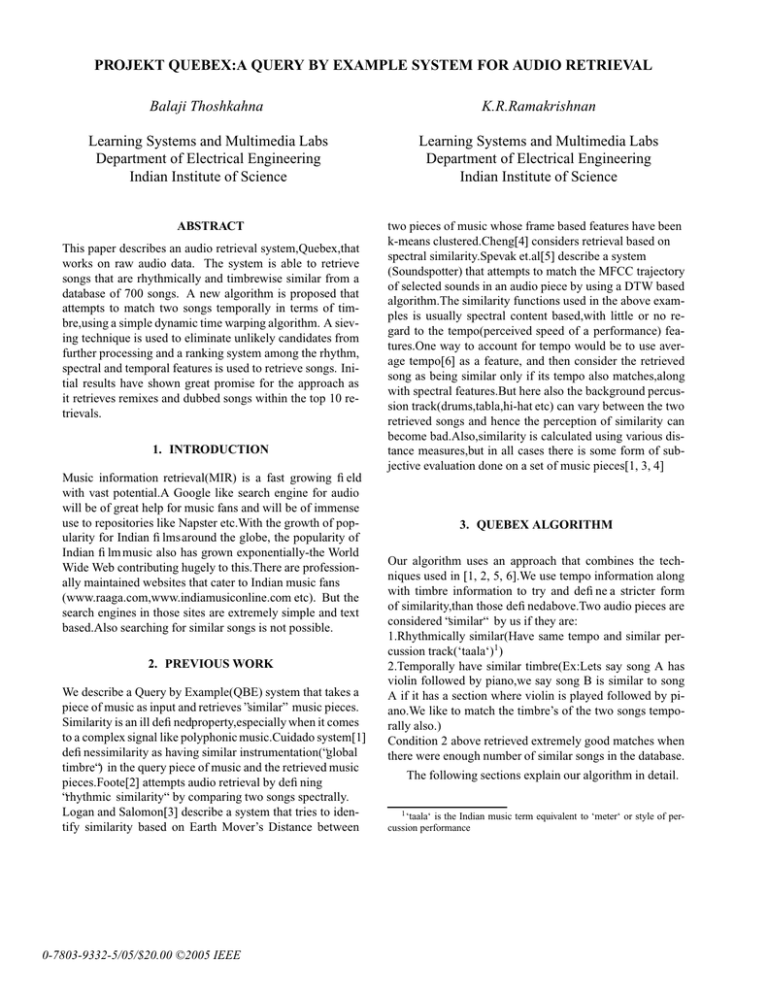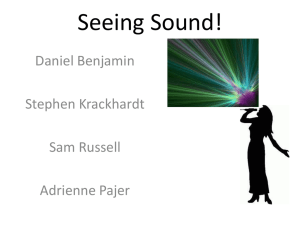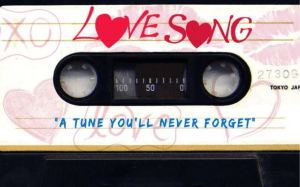PROJEKT QUEBEX:A QUERY BY EXAMPLE SYSTEM FOR AUDIO RETRIEVAL Balaji Thoshkahna K.R.Ramakrishnan
advertisement

PROJEKT QUEBEX:A QUERY BY EXAMPLE SYSTEM FOR AUDIO RETRIEVAL
Balaji Thoshkahna
K.R.Ramakrishnan
Learning Systems and Multimedia Labs
Department of Electrical Engineering
Indian Institute of Science
Learning Systems and Multimedia Labs
Department of Electrical Engineering
Indian Institute of Science
ABSTRACT
two pieces of music whose frame based features have been
k-means clustered.Cheng[4] considers retrieval based on
spectral similarity.Spevak et.al[5] describe a system
(Soundspotter) that attempts to match the MFCC trajectory
of selected sounds in an audio piece by using a DTW based
algorithm.The similarity functions used in the above examples is usually spectral content based,with little or no regard to the tempo(perceived speed of a performance) features.One way to account for tempo would be to use average tempo[6] as a feature, and then consider the retrieved
song as being similar only if its tempo also matches,along
with spectral features.But here also the background percussion track(drums,tabla,hi-hat etc) can vary between the two
retrieved songs and hence the perception of similarity can
become bad.Also,similarity is calculated using various distance measures,but in all cases there is some form of subjective evaluation done on a set of music pieces[1, 3, 4]
This paper describes an audio retrieval system,Quebex,that
works on raw audio data. The system is able to retrieve
songs that are rhythmically and timbrewise similar from a
database of 700 songs. A new algorithm is proposed that
attempts to match two songs temporally in terms of timbre,using a simple dynamic time warping algorithm. A sieving technique is used to eliminate unlikely candidates from
further processing and a ranking system among the rhythm,
spectral and temporal features is used to retrieve songs. Initial results have shown great promise for the approach as
it retrieves remixes and dubbed songs within the top 10 retrievals.
1. INTRODUCTION
Music information retrieval(MIR) is a fast growing field
with vast potential.A Google like search engine for audio
will be of great help for music fans and will be of immense
use to repositories like Napster etc.With the growth of popularity for Indian films around the globe, the popularity of
Indian film music also has grown exponentially-the World
Wide Web contributing hugely to this.There are professionally maintained websites that cater to Indian music fans
(www.raaga.com,www.indiamusiconline.com etc). But the
search engines in those sites are extremely simple and text
based.Also searching for similar songs is not possible.
2. PREVIOUS WORK
We describe a Query by Example(QBE) system that takes a
piece of music as input and retrieves ”similar” music pieces.
Similarity is an ill definedproperty,especially when it comes
to a complex signal like polyphonic music.Cuidado system[1]
definessimilarity as having similar instrumentation(“global
timbre“) in the query piece of music and the retrieved music
pieces.Foote[2] attempts audio retrieval by defining
“rhythmic similarity“ by comparing two songs spectrally.
Logan and Salomon[3] describe a system that tries to identify similarity based on Earth Mover’s Distance between
0-7803-9332-5/05/$20.00 ©2005 IEEE
3. QUEBEX ALGORITHM
Our algorithm uses an approach that combines the techniques used in [1, 2, 5, 6].We use tempo information along
with timbre information to try and define a stricter form
of similarity,than those definedabove.Two audio pieces are
considered “similar“ by us if they are:
1.Rhythmically similar(Have same tempo and similar percussion track(‘taala‘)1)
2.Temporally have similar timbre(Ex:Lets say song A has
violin followed by piano,we say song B is similar to song
A if it has a section where violin is played followed by piano.We like to match the timbre’s of the two songs temporally also.)
Condition 2 above retrieved extremely good matches when
there were enough number of similar songs in the database.
The following sections explain our algorithm in detail.
1 ‘taala‘ is the Indian music term equivalent to ‘meter‘ or style of percussion performance
3.1. Database Information
3.4. Extraction of rhythmic features
The database has 700 music pieces each of around 10 seconds(average length) taken from CD recordings and converted to ‘.wav‘ filesat a sampling rate of 16kHz.The database
contains songs from various Indian regional language movies
and albums of various international artistes and has various
genres of music(though not labelled by us).
An image processing approach based on [9]was used to extract the percussion track in each song.We assume,in our
algorithm that each song has some percussive signal which
is very valid since most Indian film songs have percussion
tracks(mridangam,tabla,ghatam,drums etc).Also the database
has over 500 of Indian songs.The mean and standard deviation of energy in the percussion signal is calculated.Energy
of the percussion signal is assumed to be the energy of the
frame that is declared to be a percussive frame(IJLK^]0MV NSPSR
and IJLK^]0MV X=Z\[ ).Once that is extracted,a smoothed version of the percussive track is used, and its autocorrelation taken and normalized and downsampled to a 50-point
template.(_@JL`ba N ]Acde for the ith song) (Note in the Fig1
that the autocorrelation function of Song 3 is different from
that of Song 2 and Song 1,since Song 1 and Song 2 are
dubbed versions of the same song.)The number of percussion hits per second is taken as the average tempo of the
song(_@JL`baU NQPSR ) (An assumption that goes bad for a few
songs when the percussion track is not maintaining the tempo).
The average and standard deviation of percussion strength
is a good indication of how strong the percussion signal is
and how consistent it is.
3.2. Extraction of Spectral Feature set
Each song is divided into non-overlapping frames of 20
milliseconds.Features such as mean and standard deviation
and ) and the number of
of spectral flux(
and ) are computed [7].
zero crossings ( 13 point MFCCs(Mel frequency cepstral coefficients)
are computed for each frame and the first8 coefficientsare
used to represent the timbre of the song[1, 8]( is the MFCC vector for the jth frame of ith song).Since
we have 10 seconds of music on an average this comes to
around 500 frames.
We now split the 10 sec music piece into frames of nonoverlapping 0.5 seconds.We take the mean and standard deviation of the MFCCs(20 msec frames) falling within each
0.5 second window and represent the group of frames within
the 0.5 second window by the above mean and standard deviation vectors.
%&('()
*
"! $# +
,.- %0/21435&('() "9 : 7 .#<;=
678
67>
?@
FGG %&4'6)
*
ED $# H + ,.- %0/21435&('() (1)
'CB
! A;
9 : 67 (2)
(3)
where j varies from 1 to 20.
This way we have a trajectory of MFCCs of 40 vectors(20 for the mean vectors and 20 for the standard deviation vectors),for every song.
3.3. Extraction of Temporal and Energy features
For each music piece,the percentage of frames that have energy less than the average energy of the music piece
(IJLK MONQPSR ) is calculated and stored.The mean and standard deviation of the song energy across frames is computed
( T$UWVR MONQPSR and T.UWVR MYX=Z\[ ).
Fig. 1. Rhythm feature based on normalized autocorrelation template.Song1 and Song2 have similar autocorrelation
functions as compared to Song3.
4. ALGORITHM FOR RETRIEVAL
A query song can be selected from the database itself using the MATLAB GUI(Fig.3).A song can be played(Using
”Play song” button) before selecting(Using ”Select song”
button)it as the query song.The algorithm will search for
similar songs in the database and retrieve the nearest 10
songs based on a ranking system.
The following steps were used for retrieval purposes:
(1).Given a query song A,a symmetric distance between the
MFCC vector tracjectories of song A and all the songs in the
database,was calculated as shown in Fig.2.That is,in the 8
dimensional MFCC space,we try to map each point of query
song A to the nearest point in song B’s trajectory (with
some temporal restriction(Fig2)).This allows for a temporal matching of the timbres between the two songs without
restricting too much and
* 1
'
'
[Ob # , ' ` V
Y\^
? W?L b\^? \ '
'
'
Y\
? L ` V
bW
? L bW
? '
'
bL
.
? S ` V Y Q ? Q! '
'
(4)
b Q
d?" #S $ Y S "
? Q where A(i) is the ith MFCC vector in the trajectory of song
A and d(A,B) is the distance of song A wrt song B.(The last
two terms of the above equation is to take care of the starting and end points)
Fig. 3. Projekt Quebex’s MATLAB GUI
between the two trajectories.The songs are ranked according to their distance from the query song( ) ).Now,Euclidean
2
, e , distance between the features
and @
of the query song A and a database song B is
calculated as follows;
'SB
[
* 0 Ob #< $? b( 'SB
[ * e Ob #< $? b( B
%
Y& $# [
* Ob+ [
* e Ob
'SB
[-, Ob #< .? 0 b( 'SB
[ , e Ob # e .? e b( B
%
@]
K Ob"# [-, 0 Ob+ [-, e Ob
(6)
(7)
(8)
(9)
(10)
(11)
for all songs in the database.The distances are again ranked
%
and . for % @]
K ).Ranking is intuitively
( . for
satisfying since the features have different orders of magnitude and adding them up as in Euclidean distances can mean
neglecting the importance of some features. A finalrank is calculated as,
Fig. 2. A suboptimal DTW mapping for distance calculation.Each node in the figurecorresponds to a 0.5 sec window’s mean/standard deviation vector in the 8 dimensional
space.
We make the distance measure symmetric,by taking an average between the two mutual distances;
%
Y& # 5[O& ' [ 4(
B
(5)
The above
distance is used on two features namely,the
! and D .This distance measure is intuitively satisfying enough,though we can consider more
complex and optimal DTW mappings to find the distance
B
B B
# /10 2 43 .
(12)
where 0 and 3 are constants of weighing the features 2
and . respectively.(This means that different features can
be given different importances.We gave a value of 1 to 0 and
0.25 to 3 ,meaning that the zero-crossings measure which relates to ‘noisyness‘ in a music piece was neglected as compared to the spectral distance measures ) and 2 )
(2).All the songs ranked in the top 50% of the above
rank ,are returned for further processing.This sieving eliminates songs whose timbre and spectral features are way too
different from the query song.
(3).Now a Euclidean distance is calculated between the
temporal features(Per Eavg,Song Eavg and Song Estd) of
query song and the database songs and the songs are ranked.
These ranks are clubbed together and a similar ranking
(”temporal feature matching
rank”),as explained above is
calculated.( Z\JL`baUWK^N )
(4).Euclidean distance between the autocorrelation templates(Calculated as the sum of the differences between the
corresponding points of each template),the mean tempo and
percussion strengths(PercEn avg,PercEn std,Templ acf(i)
and Tempo avg) are computed between the query song and
the database songs and a weighted ranking(Each of the above
said features are ranked and then the ranks are added based
on weights.Ex:If we want to match the percussion autocorrelation templates better,greater weightage is given to that
ranking)is used to get a ”rhythm feature matching rank”
( K Z>` )
(5).Now the 2 ranks are added to get a finalrank for each
of the song.
cV N # KQZ >`
B
Z\J=` aUWK^N (13)
(6).The top 10 ranked( cV N ) songs are retrieved.The
query song will always be ranked 1.This ranking system resulted in a better retrieval than simple Euclidean distance
between the features.
We believe that the human brain attempts to look for the
”strongest” feature in a song and finallytakes a decision of
similarity based on the perceptual strength of features(Ex:
Users of our system were able to accept 2 rock songs that
had different instrumentation,tempo and rhythm, but same
”noisyness”(related to zero crossing rate) as ”similar” songs).
But we don’t have a way to deduce which feature dominates
over the others.This makes retrieval by similarity challenging.Preliminary tests in our labs indicate that our direction
of thought is promising.
5. RESULTS
10 songs were randomly chosen from the database and their
retrievals were tested on 5 people.For these 10 songs,users
reported an average of 60% of the songs to be similar to the
query songs.Also the system always retrieved remixes,
dubbed versions of the same songs well within the top 10
songs.This was a self-test,in which,the system worked well.
The retrieval was bad when there were not enough songs of
the type of the query song.This has motivated us to increase
the database size to around 1500 or more songs.([1, 3] had
huge databases to start with and therefore must not have
felt this problem.[2, 4] had very few songs(around 200) and
must have had this problem(We tested the outputs for system by Foote[2] and felt this problem for some songs).
6. CONCLUSIONS AND FUTURE WORK
QBE systems that are based on perceptual similarity measures appear to be promising. Appropriate characterization
of a song/piece of recorded music ,such as done by listeners, in terms of bass,noise,rhythm etc. may be incorporated
into QBE systems. Finding suitable computational features
and descriptors to match such a characterization is a challenging task. We may need to use more than one feature set
for this purpose since no single feature might contain all the
information for such a characterization. Feature augmentation and clustering, sieving out the principal component
features for pattern matching are interesting problems for
future research.
7. ACKNOWLEDGMENTS
We would like to thank Krishna.A.G,Chandra Sekhar.S and
all our lab members for the help and encouragement.
8. REFERENCES
[1] J.J.Aucouturier and F.Pachet, “Music similarity measures:what’s the use?,” Proceedings of the 3rd International Symposium on Music Information Retrieval,
2002.
[2] M. J.Foote and U.Nam, “Audio retrieval by rhythmic
similarity,” International Symposium on Music Information Retrieval, 2002.
[3] B.Logan and A.Salomon, “A content based music similarity function,” Cambridge Research Labs - Tech Report, June 2001.
[4] C. Yang, “Macs:music audio characteristic sequence indexing for similarity retrieval,” IEEE Workshop on Applications of Signal Processing to Audio and Acoustics
., 2001.
[5] C.Spevak and E.Favreau, “Soundspotter -a prototype
system for content based audio retrieval,” 5th Intl. Conference on Digital Audio Effects(DAFx-02), 2002.
[6] E.Scheirer, “Music listening systems,” PhD Thesis,MIT, 2000.
[7] G.Tzanetakis and P.Cook, “Marsyas:a framework for
audio analysis,” Organised Sound, 2000.
[8] B. Logan, “Mel frequency cepstral coefficientsfor music modeling,” International Symposium on Music Information Retrieval, 2000.
[9] A.Klapuri, “Sound onset detection by applying psychoacoustic knowledge,” ICASSP, 1999.






